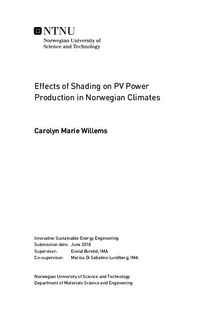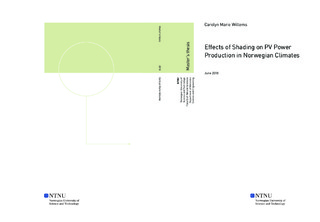| dc.description.abstract | Policy, and a significant decrease in cost have played a major role in bringing photovoltaic solar to the forefront as a renewable energy source
and a lucrative business opportunity around the world. The Norwegian solar industry is continually increasing however, due to a variability in weather patterns and a lack of accurate data, PV output predictions in Norway have proven to be less accurate than in other parts of the world where the PV industry is more established. This Master's thesis aims to provide insight into improving models, predictions and the future planning of PV systems in Norway and areas of similar climate.
The goal of this thesis is to analyze two small scale PV systems in Norway to understand the role that snow and partial shading play in the overall energy output of a system. First, a small scale building integrated system is modelled in a PV modelling software to provide a benchmark in which to compare the measured energy output. The snow coverage of the system was calculated by performing image analysis on timelapse images taken of the system and compared to the measured energy output. To understand partial shading at a system level, three shading scenarios were carried out on a small scale roof top building in Skøyen, Norway, utilizing three types of inverter technologies. Energy output values from the shading scenarios were then implemented
into an economic analysis to compare levelized costs for each technology.
This project has shown that an average daily reduction in energy output of 11 \% can be measured when snow and ice is present on a PV system in Nordic climates, however, the overall effect of snow on a system may be balanced by the increased diffuse irradiation when snow is present around the PV system but not
covering the modules. An economic analysis of a test site in Skøyen determined that micro inverters presented the lowest levelized cost when no shading was imposed on the system, followed by DC optimizers. | |

